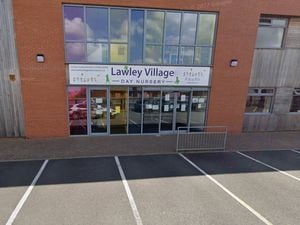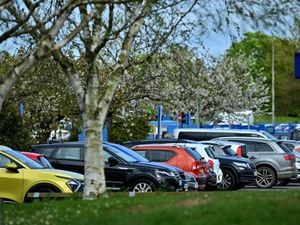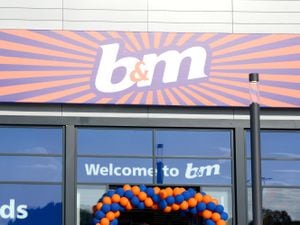Why the Shropshire floods of 2000 were a real game changer
The Great Millennium Floods of 2000 created havoc, misery and devastation in Shropshire. But they did something else. They changed the game – forever.
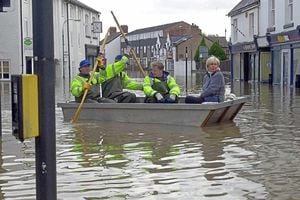
Today, 15 years ago, our region was facing high waters not seen for a generation.
Shrewsbury was among the worst affected. It faced the floods of this time 15 years ago virtually undefended apart from the traditional sandbags.
This decision was entirely voluntary. The county town had been offered flood defences by the then National Rivers Authority, but actively fought against the idea. In the face of the opposition from local councillors and residents, the £6 million flood defence scheme was abandoned.
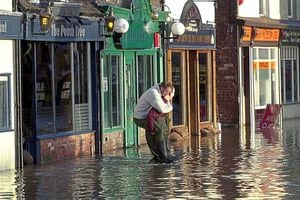
Flood waters that caused chaos in Shrewsbury 15 years ago remain burned into the memories of townspeople.
Millions of gallons of water gushed into the town effectively cutting off main routes along Smithfield Road, Abbey Foregate and Coleham Head. Roads and pavements were impassable as flood waters rose quickly.
Commuters who did venture out had horrendous journeys to work, with many of them turning back after finding roads blocked.
One of those businesses affected by the rising flood waters was The Peach Tree Restaurant in Abbey Foregate.
Owner and manager Martin Monaghan remembers the floods of 2000 well.
He and his staff spent hours moving furniture and stock out of the way and watched with dismay as the waters crept ever closer.
"We had been devastated by a number of floods in just a couple of years. It made us wonder whether we could actually continue as a business," he said. "The flood defences that are now in place have been fantastic and have made a real difference to us. They have kept the business safe in that sense.
"I think it took us several weeks to get back on our feet. We battled really hard to keep the flood water out and we reopened in quick time after the event. But none the less all the refurbishment work we have done since the floods have been with the possibility of it happening again in mind. We have been sensible about how we have been able to move forward.
"The barriers at Coleham Head have made a huge difference but once any flood water reaches those barriers we have not got much time to put our plan into action. It came very close a couple of years ago but we were fortunate. Hopefully the defences will always keep us safe."
Peter Birch, from CR Birch & Son in Roushill, saw his business under almost three feet of water. Stock was moved to a higher floor in the hours before the water invaded but the damage to the business was still huge.
"The flood of 2000 was devastating for us as it was for many other people," he said. "We had done what we could to clear shelves and move stock upstairs but to see the water was terrible.
"When the flood defences were first suggested there was to be a three-phase scheme. The first was for Frankwell, where it has worked incredibly well. The second was for Abbey Foregate, which again is a huge success and the third was mooted for Smithfield Road. But it appears the money has run out for that and because of the way the road overhangs the river it would be a huge undertaking. We still get flooded on the Smithfield Road side of the town and flood waters still get to Castle Foregate, leading to problems with transport."
In part the opposition was because of the nature of the defences proposed, which many Shrewsbury folk thought would be out of keeping with the town. A riverside wall was particularly controversial. Others doubted they would be effective anyway.
Also, modern Salopians had no experience of really serious flooding. They were prepared to cope with what nature threw at them, and put up with what seemed a bothersome inconvenience which struck at Shropshire's river towns relatively rarely.
Some even believed that the building of reservoirs and dams in Mid Wales meant that the River Severn in Shropshire would never seriously flood again.
There were to be ominous warnings that this was not so. The River Severn flooded at Shrewsbury and the Ironbridge Gorge in January 1998 and in October that year Shropshire had its worst flooding for 30 years.
With the writing on the wall still wet, the crisis came in 2000.
It was precipitated – an apt word in the circumstances – by Shropshire's wettest autumn since local records began, with 14 inches of rain in three months. The rain just kept on coming, swelling the River Severn.
There was a harbinger of the coming doom with a great gale. At the end of October 2000 barometers fell to a record low for the month and gusts of 95mph were recorded on the Long Mynd. A high profile casualty was the Boscobel Oak, a descendant of the Royal Oak, in the branches of which King Charles II had famously hid in the mid 17th century. It was seriously damaged. The storm left some homes without power.
This was just the curtain-raiser. River levels were going up and up – and then up some more.
By November 1 the Severn was at its highest level for 54 years, peaking at the Welsh Bridge at Shrewsbury at 5.25 metres – 17ft 2ins. The county town, where 400 properties were hit, and the Ironbridge Gorge, were brought to a watery halt.
Parts of Shrewsbury looked like a little Venice and could only be reached by boat. The Riverside and Pride Hill shopping centres were evacuated and closed.
Shropshire Fire and Rescue Service's river rescue boat was busy. Four pensioners were plucked from their flood-hit homes in Carline Fields, Longden Coleham, and were ferried to minibuses waiting to take them to emergency accommodation in Abbey Foregate. However another 14 residents refused to be evacuated, saying they preferred to stay put.
Crowds watched as more than 100,000 gallons of water flashed through the county town every second.
For those who take a stroll down The Wharfage at Ironbridge, here's a sobering thought – the water covered the tops of the riverside railings. That's how high it was. Dozens of properties in The Wharfage, Ladywood, and Dale End areas were awash and as residents were forced to flee their homes the Parish Rooms in Ironbridge and Madeley Court Centre were both set up as emergency rest centres for the victims. Ironbridge levels peaked at seven metres (23ft).
Bridgnorth, being downstream, could see what was coming its way and in due course was also seriously hit, with the river peaking in the town at 5.3m (17ft 3ins) on November 2. The historic Hampton Loade ferry, the last of its kind in Shropshire, sank without trace at its moorings.
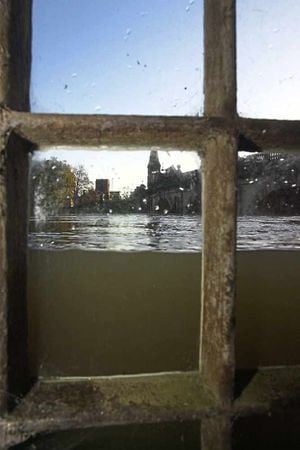
Away from the towns, a vast swathe of agricultural land in Mid Wales and the Shropshire borderlands was turned into a virtually unrecognisable landscape of lakes and pools.
At Lower House Farm, Llandrinio, Tony Dawson and wife Liz were forced to bring 120 sheep and 20 water buffalo calves into their house, as it was the only safe place.
A council boat took food parcels to marooned homes in the Melverley area.
Prime Minister Tony Blair cleared his diary so that he could come to take stock at first hand of the impact of the floods in the worst hit areas.
He made a flying visit (literally, as he came by helicopter) to Shrewsbury on November 2. During his 30-minute stop he met few members of the public, saw nothing of the flooded town centre from the ground, and spent much of his time with officials inside the Shirehall. He walked into the hub of the town's emergency control room, a 1960s bunker underneath the Shirehall, to meet the planners who had masterminded the county's fight against the floods.
Deputy Prime Minister John Prescott also arrived in Shrewsbury three days later.
And then the crisis passed, the flood waters subsided and weary residents, shopkeepers and businesses began the big task of drying out and clearing up the mess.
Then there was a hammer blow to morale. After a few weeks of recovery work, the River Severn flooded again in December, almost as badly as before and, in Bridgnorth, as badly. As before, it was preceded by gales and torrential rain.
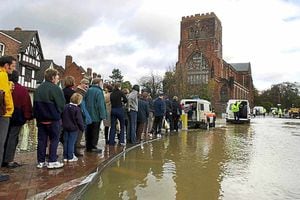
Levels peaked at Shrewsbury at 4.78m on December 12, and on that day, in his second visit to Shrewsbury, John Prescott went to the Environment Agency's Shelton headquarters. He found himself manning helplines and gave a briefing on the flooding to an antiques dealer who phoned in for advice.
The only access into the town centre within the loop of the Severn was by the English Bridge, Kingsland Toll Bridge, and Castle Foregate. Shrewsbury and Atcham Borough Council reopened its flood helpline.
The previous night the Boat Inn at Jackfield had opened for the first time since it was hit by the floods six weeks previously and around a dozen loyal customers waded in through 10 inches of water to enjoy a pint.
In Bridgnorth, some residents began to prepare for a Christmas away from their soaked homes.
The economic and physical damage caused by the two floods in quick succession was tremendous.
The psychological impact was profound. The prevailing attitude was "never again". Shrewsbury, which had celebrated when a flood defence scheme was abandoned by the NRA in 1996, was suddenly clamouring for flood defences.
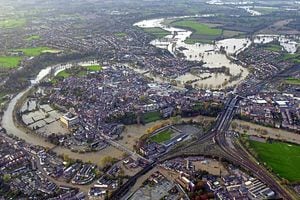
With opposition washed away, work on Shrewsbury's flood defence scheme started at Frankwell on January 7, 2002.
Ironbridge faced different technical issues, but here new technology provided the solution in the form of pallet-style portable barriers created by a Swedish company. A fraction of the cost of permanent defences, the barrier was given a "dry run" along The Wharfage on October 13, 2003.
There was not to be long to wait before they were pressed into action in earnest. There was flooding in Shrewsbury and Ironbridge on February 5 and 6, 2004. The defences came through with flying colours.
They are not a complete answer, as they do not protect all properties, and in the Ironbridge Gorge there were claims that the flood barrier offset the flooding – in other words, caused some places to flood which had never previously flooded.
The floods of 2000 were the worst since those of February 1946, when the Severn rose with unusual rapidity, hitting 600 homes in the county town, and causing huge misery and disruption. The flooding level reached 18ft 9ins above the summer level at Montford Bridge. It was the greatest flood of the 20th century.
If the cycles of the past were a reliable guide to the future, it could be the 2050s before we see anything as bad again.
But don't count on it.
Threat now alleviated
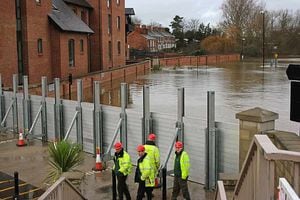
Councillors have praised the success of Shrewsbury's flood defences since they were installed after the serious flooding that occurred in 2000.
The installation of flood defences along the length of the Severn in Shrewsbury from Frankwell to Coleham Head has meant that the threat of extensive flooding has been alleviated and business owners and townspeople have not been hit.
A flood alleviation scheme, which protects over 70 properties in Frankwell, was completed within only three years of the 2000 floods. The work cost £3.5 million. The scheme involved 700 metres of defences including flood banks and walls, and about 130 metres of demountable defences at various heights.
The scheme in Coleham Head was completed in 2011 at a cost of £2.4 million and protects 80 properties including 24 businesses as well as the Abbey and the gyratory road system.
Alan Mosley, leader of Shrewsbury Town Council,
said: "They have been a major step forward to protect residential properties, transport links and to protect the town centre in terms of businesses.
"There is of course more to be done but the work that has taken place over the past 15 years has been to the great advantage of the town and the residential areas."
County councillor Peter Nutting, who represents the Copthorne ward, said: "In times of flood the town used to grind to a halt. It really killed business. Now, since the flood defences have been put in place, life carries on as normal."

